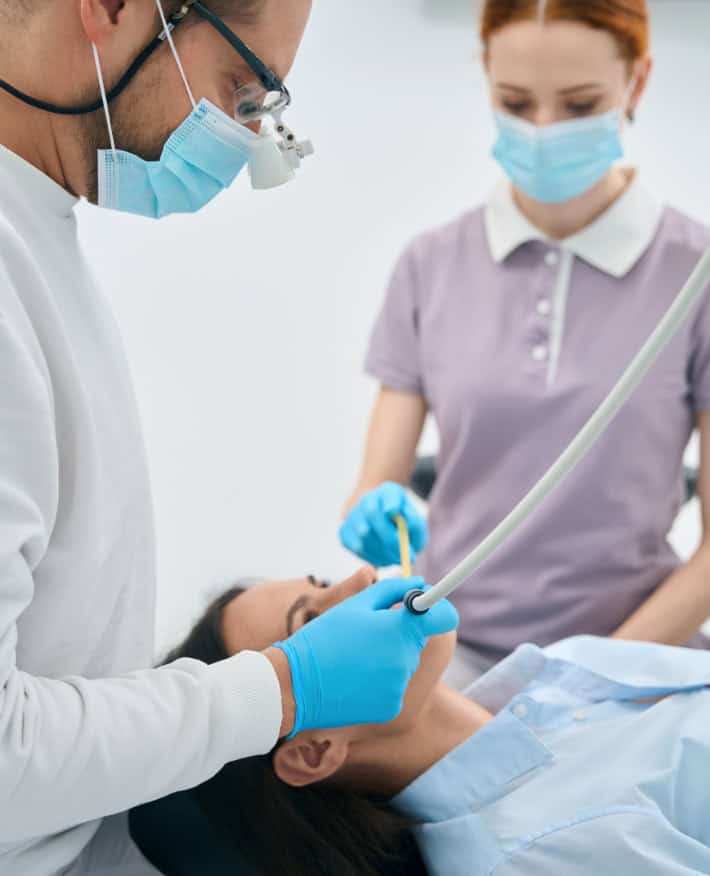Experience Professional Tooth Extractions
Discover exceptional dental care for reliable tooth extractions. Our team provides a comfortable, stress-free experience, delivering a smooth procedure and personalised aftercare to support your long-term oral health.
WHY CHOOSE
Prestige Smiles: Your Go-To Dental Partner
Prestige Smiles is more than just a dental clinic; it’s a place where your oral health is our priority. We make every step of your journey to a healthier smile seamless and stress-free.
-
- Commitment to Advanced Dental Care
- Great care starts with great knowledge. Our dentists are dedicated to continuous learning, regularly updating their skills with the latest dental techniques, technologies, and research. This means you can feel confident knowing you’re receiving modern, evidence-based care designed to support your long-term oral health and comfort.
-
- Modern Technology for Greater Comfort and Precision
- We believe great dentistry combines skill with innovation. That’s why we use advanced dental technology — from digital imaging to gentle treatment tools — to deliver care that’s more precise, more comfortable, and better tailored to your needs. It’s just one more way we help make every visit a positive experience.
-
- Exceptional Safety Standards
- Your safety is our priority. We maintain rigorous sterilisation protocols, exceed industry infection control guidelines, and continually update our practices to ensure a safe environment for every patient and every visit.
-
- Flexible Payment Plans
- We believe that quality dental care should be accessible. That’s why we offer flexible payment solutions, including Afterpay, Zip, SuperCare access, and partnerships with leading health funds like HBF, CBHS, and HIF, to help make caring for your smile easier on your budget.
-
- Transparent Treatment Planning
- We value honest communication. From your very first consultation, you’ll receive a detailed treatment plan tailored to your needs — including clear explanations of procedures, expected outcomes, and costs — so you can make informed decisions about your care with confidence.
-
- Inclusive Patient Care
- Every smile deserves to be cared for with respect and kindness. Our practice is designed to accommodate diverse needs, providing accessible facilities and creating a warm, supportive environment where every patient feels welcomed, understood, and valued.

The Importance of Tooth Extractions for Health
Persistent dental issues like infections or crowding can lead to pain, misalignment, and long-term oral health problems. If not managed, these issues may worsen, affecting overall well-being. Tooth extractions address these concerns effectively, preventing further complications. They are essential in supporting a healthier smile as part of a proactive dental care plan.
Signs You Are a Candidate for a Tooth Extraction
Some dental issues may require a tooth extraction to protect oral health and prevent further complications. Recognising the signs can help you determine if this treatment is needed. Below are common indicators that you might be a candidate for tooth extraction:
- Persistent pain or swelling in a tooth may be a sign of severe decay or infection. In such cases, removal is often recommended to prevent further damage.
- Overcrowding in your mouth, especially before orthodontic treatment, often necessitates tooth extraction for proper alignment.
- Impacted wisdom teeth can cause discomfort, infection, or damage to neighbouring teeth, making extraction necessary.
- Advanced gum disease that weakens tooth support may lead to the need for removal to protect overall oral health.


The Benefits Tooth Extraction Procedures
Tooth extractions do more than relieve pain—they address problematic teeth while helping to maintain oral health and prevent future complications. Below are the key benefits of this procedure, clearly highlighting how it supports your immediate and long-term dental well-being.
- Removing a severely damaged or decayed tooth helps alleviate pain and prevents the spread of infection to other areas.
- Tooth extractions can create the space needed to improve alignment, especially before orthodontic treatments like braces or clear aligners.
- Addressing impacted or overcrowded teeth reduces the risk of damage to surrounding teeth. It also supports better overall oral health and function.
- Extracting problematic teeth can protect gum health and promote a healthier, more functional smile.
Start Your Journey To a Healthier, Happier Smile
At The Prestige Smiles, we’re passionate about helping you achieve and maintain a smile you’ll feel proud of. Whether you’re due for a routine check-up, seeking to refresh your smile’s appearance, or need urgent dental care, we’re ready to welcome you with compassion, expertise, and genuine care.

Dental Problems That a Tooth Extraction Can Help Address
Tooth extractions can be an integral step in managing oral health. They help address specific dental concerns while supporting long-term comfort, functionality, and a healthier smile.
Unhappy With My Smile
Issues like overcrowding or impacted teeth can affect your smile’s appearance. Tooth extraction may be the first step towards creating a balanced and confident smile.
Considering Teeth Straightening
Preparing for orthodontic treatment sometimes requires removing overcrowded teeth. Extractions can create space for teeth to align properly, supporting successful and lasting results.
I Have a Dental Emergency
Severe pain or damage from infection or trauma may require urgent tooth extraction to alleviate discomfort and prevent further complications.
Seeking Smile Improvement
Tooth extractions can improve oral health and aesthetics by addressing specific dental issues. They help you achieve a more balanced and attractive smile.
Affordable Dental Care With Flexible Payment Options
Prioritising your dental health supports not only your smile but also your overall health. To make this easier, we offer payment options designed to align with your budget and lifestyle.
-
- Child Dental Benefits Schedule
- Eligible children can access essential dental services under the Australian Government’s Child Dental Benefits Schedule. Designed to support both oral and overall health, CDBS helps make early dental care more accessible for families.
-
- Dental Services for DVA Card Holders
- We proudly support Department of Veterans Affairs (DVA) cardholders, offering access to specific dental treatments to help maintain oral health with convenience and respect for your service.
-
- Afterpay
- Enjoy the flexibility of spreading your dental costs over four equal instalments — interest-free. Afterpay lets you receive the care you need now and pay over time, making dental treatments easier to manage within your budget.
-
- Zip
- With Zip, you can access dental treatments today and pay later with a flexible repayment schedule that suits you. No upfront payments needed.
-
- SuperCare
- SuperCare may assist eligible patients in accessing their superannuation early to fund necessary dental treatments. Our team can guide you through the SuperCare process to make it as smooth as possible.
-
- Pretty Penny Finance
- Looking for personalised dental financing solutions? Pretty Penny Finance offers tailored repayment options to help you manage treatment costs comfortably and confidently.
-
- HBF
- As an HBF-preferred provider, we offer quality dental care to HBF members, helping to reduce out-of-pocket expenses across a range of treatments.
-
- CBHS
- We proudly partner with CBHS Health Fund to deliver affordable, personalised dental care for members, supporting better oral health outcomes.
-
- HIF
- As a preferred provider for HIF members, we make it easier to access cost-effective dental services while maintaining the highest standards of care.
FREQUENTLY ASKED QUESTIONS
Get clear answers to common questions about tooth extraction, from reasons for the procedure to pain management, preparation, and more.
What situations require a tooth extraction?
Tooth extraction is often considered a last resort when other dental treatments can’t address an issue. Here are the main situations where an extraction might be required:
- Severe Tooth Decay:
When decay has spread deeply into the tooth structure and reached the pulp, an extraction may be recommended. This approach helps prevent the infection from spreading further. - Advanced Gum Disease:
Periodontal disease can weaken the support around a tooth, causing it to become loose. In these cases, extracting the tooth may be needed to maintain the health of surrounding teeth and gums. - Overcrowded Teeth:
In cases of dental crowding, extractions may be required to create space for proper alignment. It helps support successful and effective orthodontic treatment outcomes. - Broken or Cracked Teeth:
Teeth that are too damaged to be restored may need to be extracted to prevent pain and avoid further complications. Extraction is important if the fracture extends below the gum line. - Preparation for Dental Prosthetics:
In some cases, teeth may need to be removed to make room for dentures or other prosthetics. Extraction becomes necessary if the tooth structure is severely damaged or misaligned.
Tooth extractions are always considered carefully, with patient well-being as the priority. A dentist will recommend extraction to protect or improve oral health after evaluating all other options. If you’re experiencing any of these signs and are considering tooth extractions, our team is here to help. Contact our dental clinic today to discuss your needs and how we can provide high-quality care for your oral health.
Is tooth extraction always necessary for a damaged or decayed tooth?
Tooth extraction is not always required for a damaged or decayed tooth. Dentists usually explore alternative treatments to preserve the natural tooth before recommending extraction. Here’s a detailed look at when extraction becomes necessary:
- The Extent of Damage or Decay:
Extraction may become recommended when the tooth is severely compromised, such as with extensive fractures. Deep decay that restorative methods cannot address may also require extraction. - Risk to Surrounding Teeth:
When a decayed or damaged tooth risks infecting neighbouring teeth, dentists may advise extraction. This approach helps prevent the infection from spreading and protects overall oral health. - Bone or Gum Health Considerations:
Extraction may be considered if surrounding bone or gum tissue is severely affected, making the area unsuitable for restorative procedures. - Patient’s Long-Term Health and Comfort:
When tooth restoration may cause recurring issues, extraction can be the most suitable option to support the patient’s comfort. This approach also supports the patient’s long-term oral health.
The decision depends on the severity of the damage and individual oral health factors. By exploring all options, the dental team prioritises treatments that preserve your natural smile whenever possible.
What types of anaesthesia are used for tooth extractions?
Understanding the types of anaesthesia used can help ease concerns and reassure patients about comfort during tooth extraction procedures. Here’s a breakdown of the anaesthesia options commonly offered for tooth extractions:
Local Anaesthesia
- Local anaesthesia is the most frequently used option, numbing the specific area around the tooth.
- It is administered via an injection into the gum near the extraction site.
- This type of anaesthesia blocks pain, allowing you to stay fully awake while feeling only pressure or movement.
- Patients generally resume normal activities soon after, as it wears off within a few hours.
Sedation Anaesthesia
- Sedation can be combined with local anaesthesia for patients who feel anxious or require additional comfort.
- Depending on the sedation level, you may feel drowsy or fall into a light sleep. You’ll still be able to respond to instructions if needed.
- Sedation can be administered through IV (intravenous) or oral medication and helps reduce anxiety during the procedure.
- This type requires a longer recovery period, so you may need someone to drive you home after the appointment.
General Anaesthesia
- General anaesthesia is less common for tooth extractions and is typically reserved for complex cases like multiple extractions.
- Under general anaesthesia, patients are fully asleep, with no memory of the procedure.
- It’s administered in a controlled environment. Due to the strength of the medication, recovery time may be longer.
- Patients should arrange transportation and additional recovery time following a procedure with general anaesthesia.
Knowing your anaesthesia options supports a personalised approach, making your experience as stress-free and comfortable as possible.
What should I expect during a tooth extraction procedure?
Understanding what happens during a tooth extraction can help ease any concerns and give you confidence going into the procedure. Here’s a step-by-step overview of what to expect:
- Preparation and Anaesthesia:
Before starting, your dentist will review your medical history, discuss any medications, and address questions to keep you fully informed. Local anaesthesia will be applied to numb the area around the tooth, providing minimal discomfort. For patients who experience anxiety, sedation options may also be discussed. - Loosening the Tooth:
Once numb, the dentist will gently loosen the tooth from the surrounding bone and tissue using a specialised instrument. This step makes removal easier; you may feel some pressure, but there should be no pain. - Removing the Tooth:
After the tooth is sufficiently loosened, the dentist will carefully extract it. This step may vary slightly depending on the complexity of the extraction. For some teeth, particularly molars or impacted teeth, small incisions or sectioning may be required to allow a smooth removal. - Controlling Bleeding:
After removing the tooth, the dentist places gauze on the site to control bleeding and promote blood clot formation. You may be asked to bite down on the gauze for a few minutes. The dentist may also provide additional gauze to use later if bleeding persists. - Post-Extraction Instructions:
Before leaving, you’ll receive instructions on managing pain, swelling, and aftercare to support a smooth healing process. The dentist may also recommend over-the-counter pain relief options and guidance on foods to avoid.
With these steps, tooth extraction is generally quick and straightforward. Being aware of each stage and knowing how to handle common complications post-tooth extraction can reduce anxiety.
How long does a tooth extraction take from start to finish?
Tooth extraction recovery varies on factors such as the complexity of the procedure and the patient’s unique healing process. Here’s a general breakdown of what you can expect from the procedure:
- Preparation:
The dentist will review your medical history, take any necessary X-rays, and apply local anaesthesia to maintain comfort. This initial step may take about 10-15 minutes. - Extraction Process:
For a simple extraction, the dentist gently loosens the tooth from its socket. The process usually takes 5-15 minutes, depending on the tooth’s complexity. - Immediate Aftercare:
Once the tooth is removed, the dentist will apply gauze to help end any bleeding and may give aftercare instructions. This step usually takes an additional 5-10 minutes.
A typical extraction appointment lasts 20-40 minutes. Adhering to your dentist’s aftercare instructions supports a smooth tooth extraction recovery and helps minimise the risk of complications.
How painful is tooth extraction, and what can I do to manage discomfort afterwards?
Experiencing some level of discomfort after a tooth extraction is normal, but the pain is often manageable with proper care. Here’s what to expect and how to ease any discomfort during recovery:
- Mild to Moderate Pain:
Most patients feel only mild to moderate soreness following the procedure, especially once the anaesthesia wears off. This discomfort is usually manageable and tends to decrease within a few days. - Over-the-counter Pain Relief:
Swelling and a lingering ache at the extraction site are the common complications post-tooth extraction that patients experience. Medications prescribed by your dentist can help relieve pain and reduce inflammation. - Apply Cold Packs:
Use a cold compress on the outside of your cheek near the extraction site. It helps ease pain and provides immediate, temporary relief within the first 24 hours after the procedure. - Limit Physical Activity:
Take it easy for the first 24 hours, avoiding strenuous activities that could increase blood flow and prolong recovery time. - Follow Dietary Guidelines:
Stick to soft foods and avoid hot, spicy, or crunchy foods that may irritate the area. Drinking plenty of water can also aid healing. - Oral Hygiene Tips:
After 24 hours, gently rinse your mouth with a warm saltwater solution. Avoid vigorous rinsing, as it can dislodge the clot and delay healing.
With these simple steps, you can manage discomfort and support a smooth, comfortable tooth extraction recovery process. Following post-operative care guidelines can help reduce pain after tooth extraction and support the healing process.
What should I do to prepare for a tooth extraction appointment?
Preparing for a tooth extraction appointment helps create a smooth and comfortable experience. Here are some essential steps to follow:
- Discuss Medications with Your Dentist:
If you’re taking any prescription or over-the-counter medications, inform your dentist well in advance. Some medications, such as blood thinners, may need adjustment to reduce the risk of excessive bleeding during the procedure. - Ask Questions:
Talk to your dentist about the procedure, recovery timeline, and ways to manage pain after tooth extraction. Be sure to address any other questions or concerns you may have. Gaining insight into the process can help you feel more comfortable. - Arrange Transportation:
If undergoing sedation, it’s helpful to have a friend or family member drive you to and from your appointment. Having someone with you can offer support and peace of mind, especially if you feel drowsy afterwards. - Avoid Eating or Drinking, as Advised:
If your dentist has recommended sedation for the extraction, you’ll likely be advised to fast. Avoid eating or drinking for several hours to allow the anaesthesia to work safely. If fasting isn’t required, have a light meal beforehand, as you may not feel like eating right after the extraction. - Dress Comfortably:
Wear loose, comfortable clothing on the day of your procedure to help you relax and stay comfortable. Avoid wearing accessories like jewellery, as they may need to be removed. A short-sleeved shirt may be helpful if your dentist needs to take your blood pressure or administer IV sedation. - Prepare for Recovery at Home:
Set up a comfortable area at home with essentials like soft foods, extra pillows, ice packs, and any prescribed medications. Plan to rest for at least 24 hours after the procedure, avoiding strenuous activities.
By taking these steps, you’ll be well-prepared for a comfortable and efficient tooth extraction appointment.
Are there any risks or complications associated with tooth extractions?
While tooth extractions are generally reliable, patients should be aware of some risks and complications. Understanding these can help you prepare and follow recommended aftercare steps to promote a smooth recovery.
- Infection:
There is a minor risk of infection if bacteria enter the site after an extraction. Signs include swelling, increased pain, or a fever. Good oral hygiene and following post-extraction care instructions can significantly reduce this risk. If you experience severe or prolonged pain after tooth extraction, reach out to your experienced dentist for advice. - Dry Socket:
Dry sockets occur when the blood clot at the extraction site dislodges or dissolves too early. This exposure leaves underlying nerves and bones vulnerable, causing discomfort and delaying healing. They can cause intense pain a few days after the procedure. Avoiding activities like smoking and following dietary recommendations can help prevent dry sockets. - Excessive Bleeding:
It’s normal to experience some bleeding right after the procedure, but prolonged or heavy bleeding may indicate an issue. Placing gentle pressure with gauze and avoiding certain foods can help manage this risk. - Swelling and Bruising:
Swelling and bruising are common complications post-tooth extraction, usually subsiding within the first one to two days. Cold compresses and prescribed medications can help minimise these symptoms and promote healing.
While these complications are rare, your dentist will provide detailed aftercare instructions to minimise risks. Following these guidelines and promptly addressing unusual symptoms with your dental team will support a safe and comfortable recovery.
Discover Exceptional Dental Care. Schedule Your Visit With Us Today!
Trust us with your dental health and experience a welcoming environment, professional treatments, and personalised care. Schedule your appointment today and discover the impact we can have on enhancing your smile.